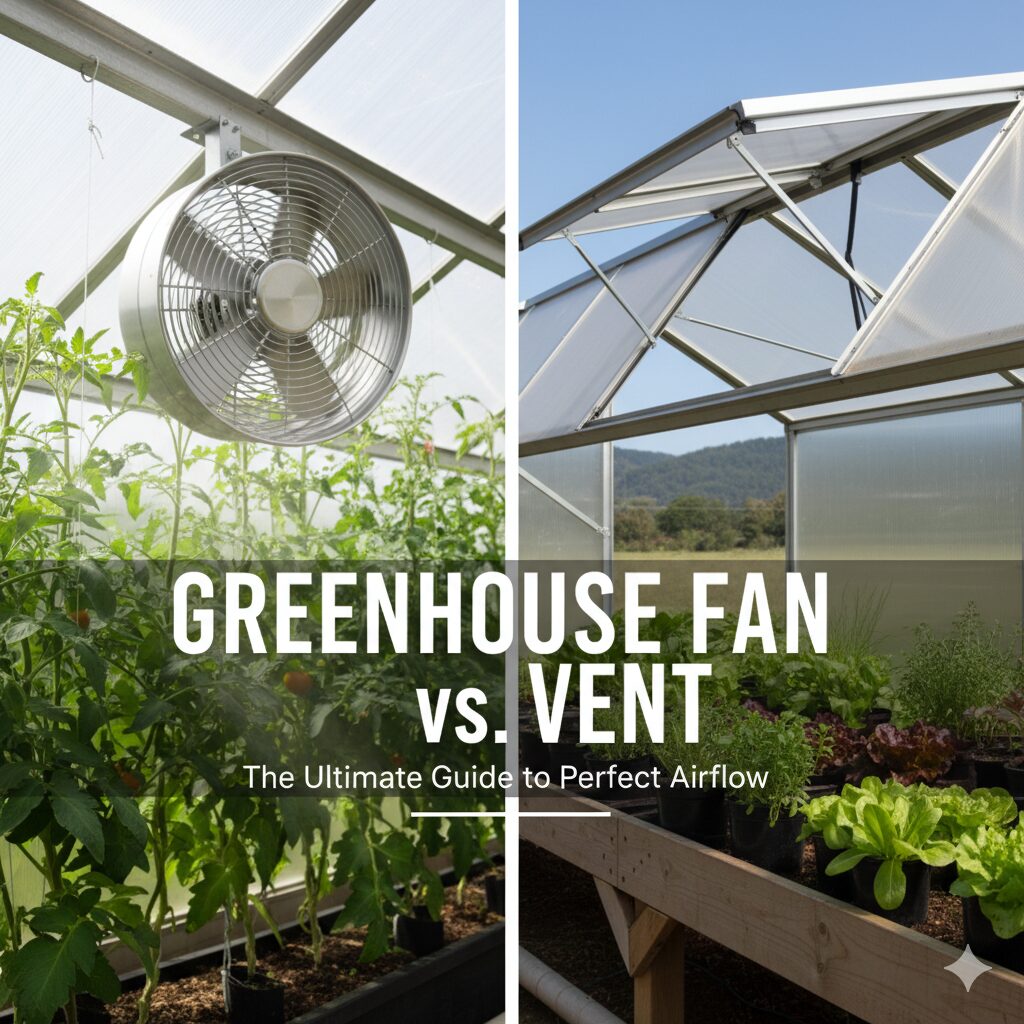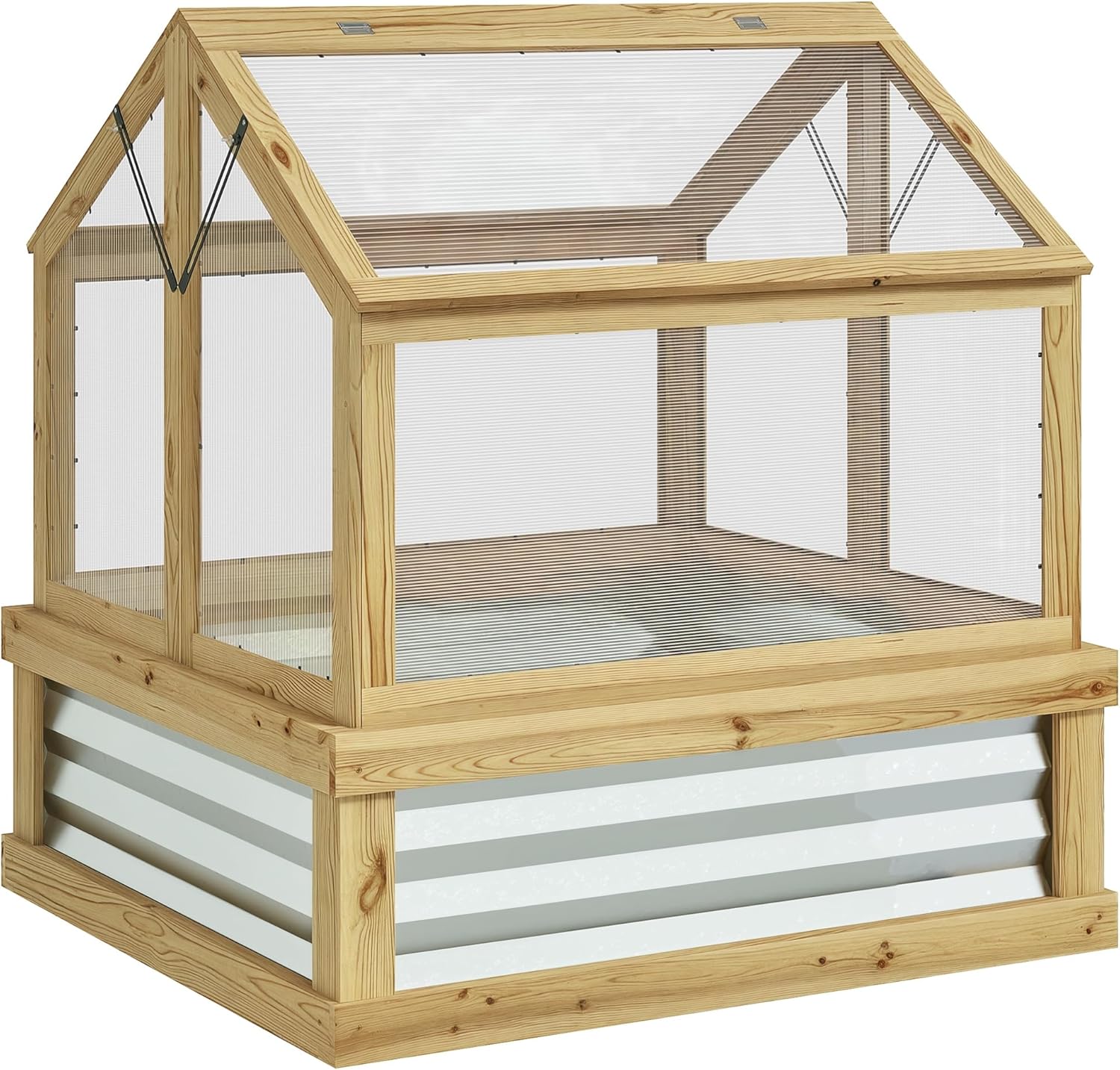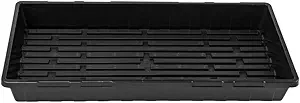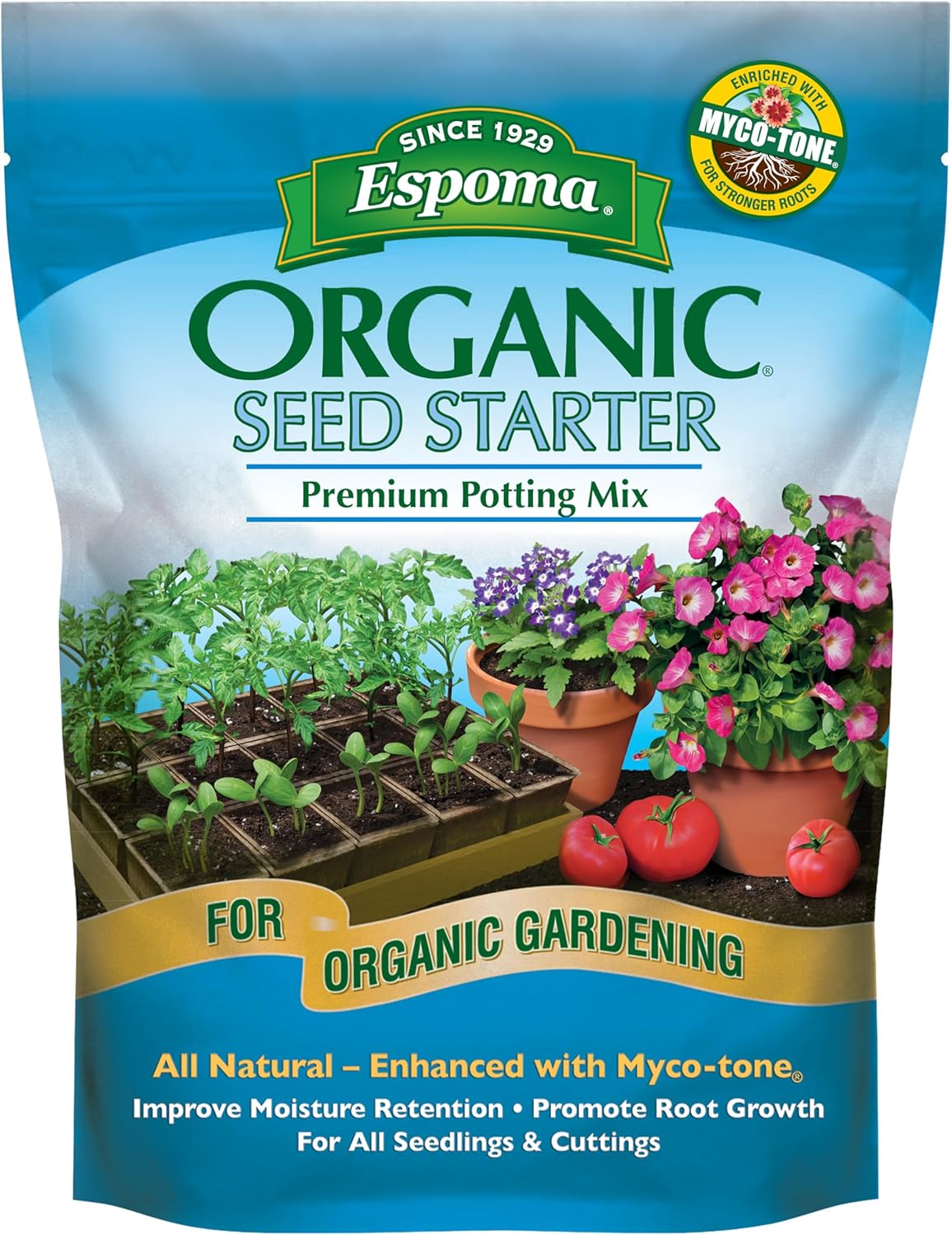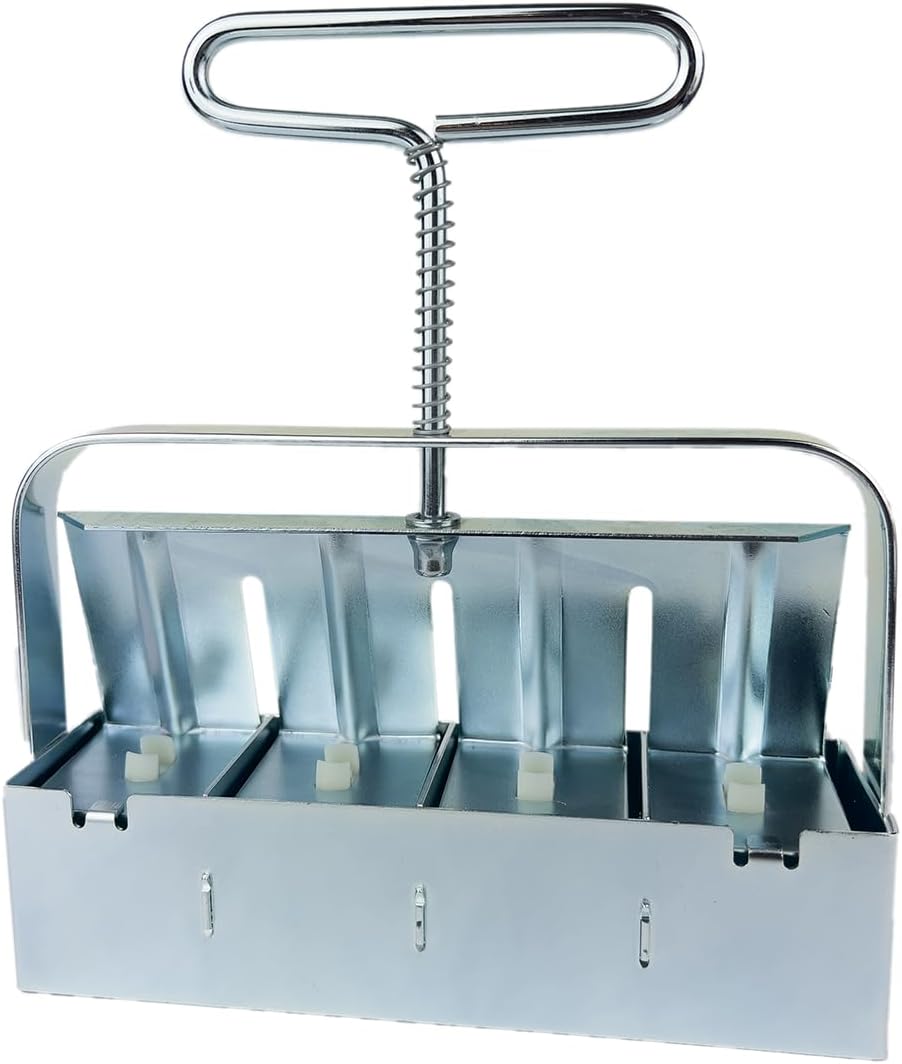Greenhouse Fan vs. Vent: The Ultimate Guide to Perfect Airflow
Stepping into your greenhouse on a sunny day should feel like entering a plant paradise, not a sweltering sauna. But without proper airflow, that’s exactly what happens. The question isn’t if you need ventilation, but how. This guide will definitively answer the age-old debate for American gardeners: Should you choose fans, vents, or a combination of both for a thriving, healthy greenhouse?
At a Glance: Fans vs. Vents Quick Comparison
For those who want the bottom line right away, here’s a high-level comparison. We’ll dive deep into each aspect below, but this table provides a clear snapshot to get you started.
| Feature | Greenhouse Vents (Passive) | Greenhouse Fans (Active) |
|---|---|---|
| Mechanism | Uses natural convection; hot air rises and escapes through openings. | Uses mechanical power to physically pull hot air out and push cool air in. |
| Effectiveness | Highly dependent on weather; less effective on still, calm days. | Consistently effective regardless of outside wind conditions. |
| Cost | Lower initial cost. No ongoing electrical costs. | Higher initial cost for the unit, plus ongoing electricity costs. |
| Control | Less precise. Manual or basic automatic openers. | Highly precise, especially when paired with a thermostat. |
| Noise Level | Silent. | Audible noise from the motor and blades. |
| Maintenance | Low. Occasional cleaning and lubrication. | Moderate. Requires cleaning, motor checks, and potential belt replacement. |
| Best For | Hobbyists in mild climates, small greenhouses, off-grid setups. | Serious growers, large greenhouses, hot/humid climates, precision control needs. |
The Silent Threat: Why Greenhouse Ventilation is Non-Negotiable
Before we pit fans against vents, it’s crucial to understand why this is such a vital topic. A greenhouse’s greatest strength—its ability to trap solar energy—is also its greatest weakness if left unchecked. On a mild, sunny 75°F day, the interior of an unventilated greenhouse can easily soar past 120°F, cooking your beloved plants in a matter of hours.
Effective ventilation accomplishes three critical tasks:
- Temperature Regulation: The primary goal is to expel super-heated air and draw in cooler, fresh air, keeping the temperature within the ideal range for your plants (typically 70-85°F).
- Humidity Control: Stagnant, humid air is a breeding ground for fungal diseases like powdery mildew and botrytis. Proper airflow wicks away excess moisture from plant leaves and the surrounding air, creating a healthier environment. Avoiding these issues is far easier than trying to fix them, a lesson many learn the hard way and one of the most common greenhouse mistakes to avoid.
- CO₂ Replenishment: Plants “breathe” in Carbon Dioxide (CO₂) for photosynthesis. In a sealed greenhouse, CO₂ levels can become depleted, stalling plant growth. Ventilation constantly replenishes the supply of fresh, CO₂-rich air from outside.
Think of your ventilation system as the lungs of your greenhouse. Without it, your entire ecosystem suffocates. Now, let’s explore the first method of “breathing”: passive ventilation through vents.
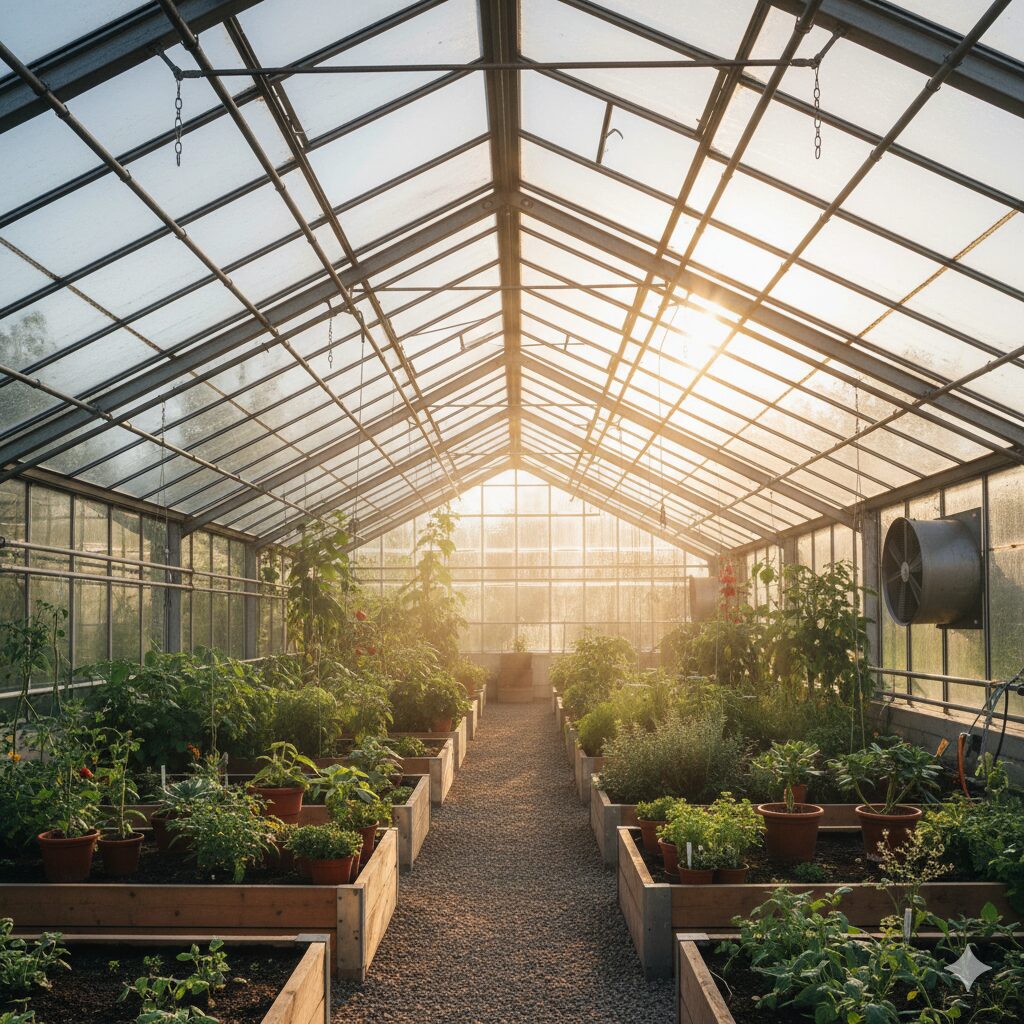
Deep Dive: The Case for Greenhouse Vents (Passive Ventilation)
Passive ventilation is the art of using nature’s own physics to cool your greenhouse. It’s an elegant, simple, and often surprisingly effective solution that relies on the scientific principle of convection: hot air is less dense than cold air, so it naturally rises.
How Do Vents Work? The Chimney Effect
The strategy is simple: provide an exit for hot air at the top and an entrance for cool air at the bottom. This creates a continuous, natural cycle.
- Roof Vents: These are the most critical component. Placed at the highest point of the greenhouse (the ridge), they act like chimneys, allowing the hottest air to escape directly.
- Side or Base Vents: Often louvered, these are positioned low on the greenhouse walls. As hot air exits through the roof vents, a pressure difference is created, pulling cooler, heavier air in through these lower openings to replace it. Roll-up sides on hoop houses serve the same purpose on a larger scale.
This natural “chimney effect” creates a gentle but constant flow of air, cooling the structure without any mechanical intervention.
Pros of Vents
- Zero Running Costs: The biggest advantage. Vents don’t use electricity, saving you money on your utility bill and reducing your carbon footprint.
- Silent Operation: Enjoy the peace and quiet of your garden without the constant hum of a fan motor.
- Low Maintenance: Once installed, vents require very little upkeep. A yearly check is part of a good greenhouse maintenance checklist, but it’s usually just a quick clean and lubrication of moving parts.
- High Reliability: With no motors, belts, or wiring, there’s very little that can break. Automatic vent openers use a wax-filled cylinder that expands with heat, a beautifully simple and reliable technology.
- Off-Grid Friendly: The perfect solution for greenhouses without access to a power source.
Cons of Vents
- Weather Dependent: Their effectiveness plummets on hot, still, and overcast days when there’s no breeze to help initiate the airflow cycle.
- Slower Cooling: Passive ventilation cools the space more gradually than a powerful fan. It can struggle to keep up during a sudden heatwave.
- Less Precise Control: While automatic openers are great, you don’t have the fine-tuned control that a thermostat-linked fan provides.
- Pest & Pollen Entry: An open vent is an open door for insects and airborne pollen or weed seeds. While screens can be fitted, they can slightly reduce airflow.
- Sizing is Crucial: You need enough vent area to be effective—generally recommended to be at least 20% of your greenhouse’s floor area.
Expert Takeaway on Vents: Vents are the ideal starting point for most hobbyist gardeners in the U.S., especially in zones 4-7 where summer heat is significant but not extreme. They are a cost-effective, silent, and reliable way to manage temperature. For maximum efficiency, always pair roof vents with lower side vents to create a strong convective loop.
Deep Dive: The Power of Greenhouse Fans (Active Ventilation)
If vents are the lungs, fans are the heart of a ventilation system—actively pumping air to create a powerful, controlled environment. Active ventilation uses electricity to mechanically force an air exchange, giving you ultimate command over your greenhouse climate, regardless of the weather outside.
How Do Fans Work? Creating a Wind Tunnel
The most common setup for active ventilation involves two key components:
- Exhaust Fan: This is the workhorse. Mounted high on one end wall of the greenhouse, it actively sucks hot, stale, humid air out of the structure.
- Intake Shutters/Vents: Placed at the opposite end wall, low to the ground. These shutters are designed to open automatically from the negative pressure created when the exhaust fan turns on. This placement pulls cool, fresh air in from near the floor, which then travels the length of the greenhouse, absorbing heat before being expelled by the fan.
This system guarantees a complete air exchange in a set amount of time, typically once every one to two minutes. This rate is measured in CFM (Cubic Feet per Minute). Calculating the correct CFM for your fan is critical and a sign of a well-planned setup. The basic formula is:
Required CFM = Greenhouse Length x Width x Height
For example, a 10′ x 12′ x 8′ (at the peak) greenhouse has a volume of 960 cubic feet. To ensure a full air exchange every minute, you’d need a fan rated for at least 960 CFM. It’s always wise to oversize your fan slightly (by about 25%) to account for inefficiencies and extreme heat.
Don’t Forget Circulation Fans!
A second type of fan, the Horizontal Airflow (HAF) fan, is just as important. These don’t vent air outside; they simply circulate it inside the greenhouse. This prevents stagnant air pockets, ensures even temperature distribution, and strengthens plant stems. Most experts recommend running HAF fans 24/7 for optimal plant health.
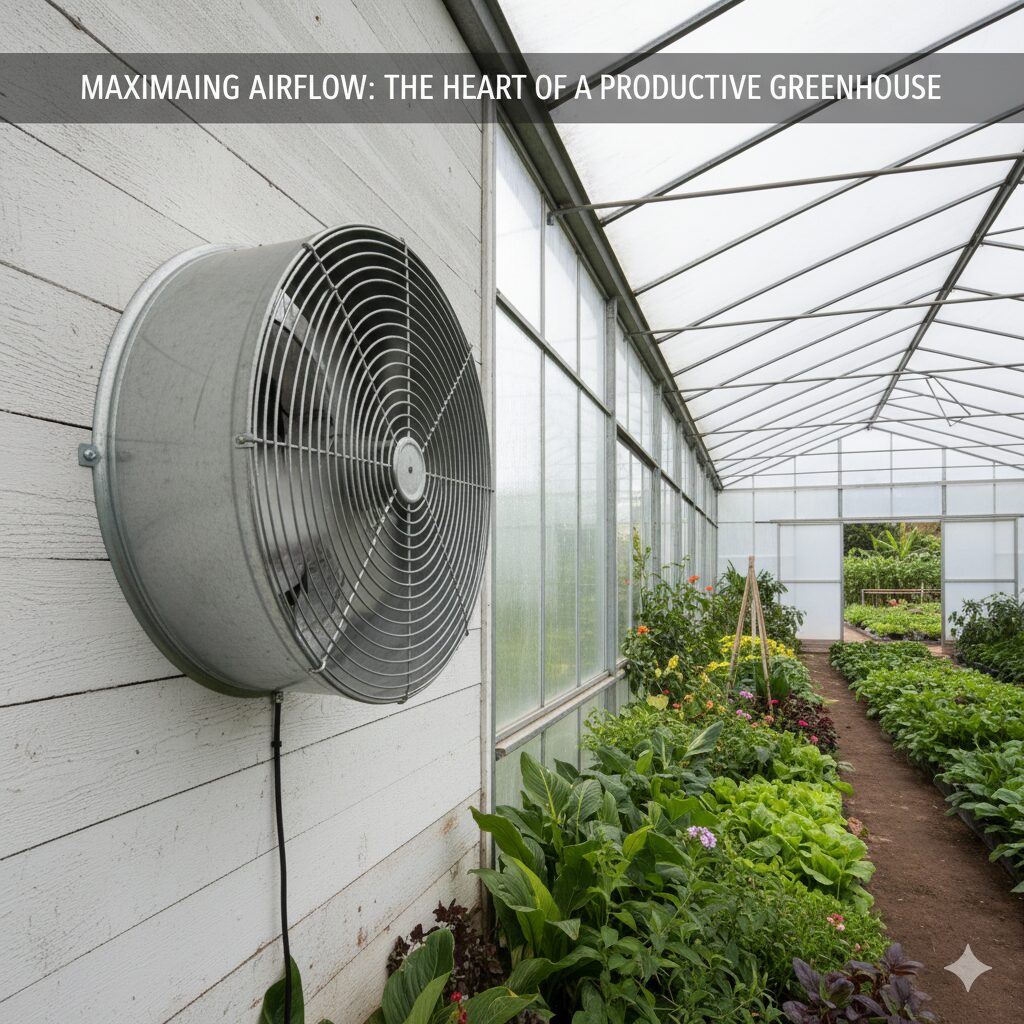
Pros of Fans
- Unmatched Power: A correctly sized fan system can keep a greenhouse cool even on the hottest, stillest days in places like Texas or Florida.
- Precise Automation: When connected to a thermostat, a fan provides set-it-and-forget-it temperature control. The system automatically kicks on and off to maintain your desired temperature range.
- Rapid Air Exchange: Fans can replace the entire volume of air in a greenhouse in as little as one minute, quickly purging heat and humidity.
- Enhanced Pest Control: Intake shutters can be easily fitted with insect screens, creating a much more secure barrier against pests than an open vent. This is a huge benefit when trying to figure out how to stop whiteflies in greenhouses and other common invaders.
- Consistent Performance: Their effectiveness is not dependent on the weather, providing reliability and peace of mind.
Cons of Fans
- Requires Electricity: This is the biggest barrier. You need a power source, and it will add to your monthly utility bill.
- Higher Initial Investment: A quality exhaust fan, intake shutter, and thermostat kit costs significantly more than a set of manual or automatic vents.
- Noise: Even the quietest fans produce a noticeable hum, which can detract from the tranquility of a garden space.
- More Maintenance: Motors need to be kept clean, belts may need tightening or replacing, and shutters require regular cleaning to operate smoothly.
- Potential for Failure: A motor can burn out or a power outage can render your system useless during a critical heatwave, requiring a backup plan.
The Ultimate Solution: A Hybrid System Approach
After reviewing the pros and cons, you might realize that the debate isn’t about choosing one *over* the other. For the dedicated U.S. gardener, the ultimate solution is often a hybrid system that combines the best of both worlds.
Here’s how a professional-grade hybrid system works:
- Passive First: Your automatic roof vents are the first line of defense. On a mild day, they will open to release rising heat, operating silently and for free.
- Active as Backup: Your exhaust fan is connected to a thermostat set a few degrees higher than your roof vent’s opening temperature. For example, the vents might start opening at 75°F, but the fan is set to kick on only if the temperature continues to rise and hits 85°F.
- Constant Circulation: Meanwhile, your HAF (circulation) fans run continuously to keep the air moving, preventing hot spots and strengthening your plants.
This layered approach gives you energy efficiency on mild days and powerful, automated protection when you need it most. It’s the most resilient, effective, and efficient way to manage your greenhouse environment, allowing for successful greenhouse gardening year-round, from the cool springs of the Northeast to the scorching summers of the Southwest.
Key Factors in Your Decision
The right choice for your neighbor might not be the right choice for you. Here are the critical factors to weigh for your specific situation.
1. Your Climate and Location
This is the number one consideration. A gardener in Seattle, Washington, has vastly different cooling needs than one in Phoenix, Arizona.
- Mild Summers (e.g., Pacific Northwest, Upper Midwest): You can likely rely on a robust system of roof and side vents. A fan might be overkill, except for maybe a small circulation fan.
- Hot, Dry Summers (e.g., Southwest): Fans are practically a necessity. The intense, dry heat requires powerful, active air exchange to keep temperatures from becoming lethal.
- Hot, Humid Summers (e.g., Southeast): A powerful exhaust fan system is crucial not just for cooling, but for humidity control to prevent rampant fungal diseases.
2. Greenhouse Size and Material
The larger the greenhouse, the more air you need to move. A small 6’x8′ hobby house can often be managed with two roof vents and a louvered side vent. A 24’x48′ structure will absolutely require a high-CFM exhaust fan system. The material also matters. A structure with a single layer of film will lose heat faster than a greenhouse with glass or twin-wall polycarbonate, which retains more heat and thus requires more assertive ventilation.
3. Your Plants
What are you growing? Orchids and tropicals might appreciate the higher humidity that a less aggressive vent system provides. On the other hand, tomatoes, cucumbers, and peppers thrive in a drier, breezier environment to prevent blight and mildew, making a fan system highly beneficial. Your choice of the best greenhouse covering will also influence the internal light and heat, which in turn affects your plants’ ventilation needs.
4. Budget and Power Access
Be realistic about your budget. Vents are far cheaper upfront. If your greenhouse is far from your home, the cost of running weatherproof electrical wiring can be substantial, making a passive, off-grid vent system much more attractive. Also consider the long-term cost of electricity for running a fan several hours a day during the summer.
5. Your Lifestyle and Desired Automation
How hands-on do you want to be? If you’re home often and enjoy tinkering, manually opening and closing vents might be fine. If you work a 9-to-5 job or travel frequently, an automated system is essential. While automatic vent openers are a great form of passive automation, nothing beats the precision and reliability of a thermostat-controlled fan for true peace of mind.
Expert Product Picks for U.S. Gardeners
We’ve curated a list of top-rated ventilation products available on Amazon, selected for their reliability, performance, and positive reviews from fellow gardeners.
Top Pick: Automatic Vent Opener

Univent Automatic Vent Opener
This is the classic, solar-powered workhorse. The wax-filled cylinder expands in the heat to automatically open your vent and contracts as it cools to close it. No electricity or batteries needed.
Why We Recommend It:- Extremely reliable and durable Danish engineering.
- Lifts up to 15 lbs and opens up to 18 inches.
- Easy to install on most greenhouse models.
- The definition of “set it and forget it” passive cooling.
Top Pick: Greenhouse Exhaust Fan Kit

iPower 12-Inch Shutter Exhaust Fan with Thermostat
For those needing serious air-moving power, this all-in-one kit from iPower is a fantastic value. It includes the exhaust fan, motorized intake shutters, and a pre-wired thermostat for simple plug-and-play installation.
Why We Recommend It:- Powerful performance suitable for medium to large hobby greenhouses.
- Comes with everything you need for a complete active system.
- Built-in thermostat allows for precise temperature control.
- Durable aluminum blades and weather-resistant housing.
Top Pick: Horizontal Airflow (HAF) Fan

AC Infinity Cloudray S6 Grow Tent Clip Fan
While marketed for grow tents, this fan is perfect as a HAF circulation fan in a greenhouse. It’s quiet, energy-efficient, and designed for 24/7 operation. The secure clip mount makes it easy to position anywhere.
Why We Recommend It:- EC motor is whisper-quiet and highly energy efficient.
- 10-speed control to fine-tune your airflow.
- IP-44 rated for resistance to humidity and dust.
- Excellent for eliminating stagnant air pockets and preventing disease.
A good ventilation system pairs perfectly with an efficient watering solution. Consider setting up one of the best drip irrigation kits to ensure your plants get consistent moisture without making the air overly humid.
Check Price on AmazonFrequently Asked Questions (FAQ)
How many vents or fans do I need?
For vents, aim for a total vent area (roof and side combined) that is at least 20% of your greenhouse’s floor area. For fans, calculate your greenhouse’s volume (Length x Width x Height) to get the required CFM rating. It’s always better to slightly oversize than to undersize.
Can I just use a regular box fan from a hardware store?
This is not recommended. Regular household fans are not designed for the high humidity and temperature fluctuations in a greenhouse. They are not weather-resistant and their motors can pose a fire hazard in damp conditions. Always use a fan specifically rated for outdoor or greenhouse use (often called an “agricultural” or “industrial” grade fan).
Do I really need intake shutters for my exhaust fan?
Yes, absolutely. Without a dedicated intake, the fan will struggle and pull air from every crack and gap, which is highly inefficient. Properly placed intake shutters ensure the cool air enters low and travels across your plants before being exhausted, creating the most effective cooling path.
How can I power a fan in an off-grid greenhouse?
A solar-powered ventilation system is your best bet. You can purchase kits that include a solar panel, a charge controller, a battery, and a DC-powered fan. This provides a sustainable and self-sufficient way to run an active ventilation system without being connected to the grid.
Conclusion: It’s Not a Battle, It’s a Partnership
The great greenhouse “fan vs. vent” debate isn’t about choosing a winner. The real takeaway is that you need a ventilation strategy, not just a piece of equipment.
- For the budget-conscious hobbyist in a mild U.S. climate, a well-planned system of automatic vents is an elegant, effective, and free-to-run solution.
- For the serious grower in a challenging hot or humid climate, a powerful, thermostat-controlled fan system is a non-negotiable tool for protecting your investment and ensuring success.
- And for the gardener who wants the absolute best of both worlds, a hybrid system that uses passive vents for mild days and an active fan for extreme heat offers the ultimate in efficiency, control, and peace of mind.
By understanding the principles of airflow and honestly assessing your climate, budget, and gardening goals, you can design the perfect system to keep your greenhouse and your plants breathing easy, season after season.

